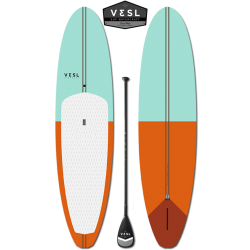The surfboard balance is a settling rudder fixed to the rear of the surfboard to hold it back from sliding sideways. In bygone times, surfers would settle the load up by hanging the toes of their back foot over the edge of the load up and would coordinate by putting their foot in the water. The American surfer Tom Blake rushed to investigate various roads with respect to adding a cutting edge to a surfboard, attaching the tumble from an old speedboat to a surfboard in 1935. Around several years afterwards stand up paddle board sales woody “Creepy crawly” Brown openly cultivated a near arrangement, anyway Brown himself gave Blake need: “I made my first surfboard fall around ’36 or ’37, some spot in there; about a comparative time. However, I thought nothing about Blake and his tests with adding edges to surfboards. Clearly, we were completely separated. I was in San Diego and he was in L.A., far up there.”.

The format of the high-level surfboard balance was made by George Greenough during the 1960s. The single equilibrium changed little until the last piece of the 70s when a second was added and advanced by Australian Mark Richards. In October 1980, resulting in seeing a twin cutting edge surfboard with a “trigger point” balance Simon Anderson had the idea for a new, comparable size, interpretation of the current three equilibrium models which was therefore named the “motor”. He made a model and following 30 years his “motor” plan is at this point the most well known sharp edge plan for surfboards.
During the 90s removable equilibrium structures were made and embraced. This gives a standardized structure that grants adjust to being viably wiped out or superseded, utilizing set fixes to hold the cutting edges. This headway opened the market to an extent of cutting edge plans, including single foiled equilibriums, indented inside surfaces, and twisted equilibriums. Another assortment of edges was in this manner in the period of time known as the soul balance, a smooth bendable association.
Surfboard fins designing :
Entry adjusts were envisioned during the 1960s by Richard Deese and were found on longboards by different makers of that period, including Dewey Weber. Influence Bolen, A.K.A. ‘the Greek’, ensured the “Super Tunnel” in the last piece of the 1990s.
Since the mid-1990s, half entry edges have generally been used on very long void wooden surfboards essentially surfed by Roy Stuart.
Slug Fins were envisioned in 2005 by Ron Pettibone to extend surfboard body planing and rail-to-rail progress speed. The patent-impending equilibriums rely upon 50 years of hydrodynamic assessment on the bulbous bow body plan. Additionally similarly with the bow of a boat, the ordinary surfboard edge makes a wave as it evacuates the water in its manner. The resulting unevenness places the surfboard. The bulb of the Bullet Fin diminishes this drag by making a new fundamental balance wave before the main assistant wave. This new bulb wave is expected to be just about 180 degrees out of stage with the main cutting edge wave to deduct its roughness thus diminishing equilibrium drag.
Equilibriums with winglets and little wings were envisioned in 2005. The inspiration driving winglets, as in plane arrangement, is to construct lift level turning power by virtue of surfboard adjustments while reducing drag, by diminishing the sharp edge tip vortex.


